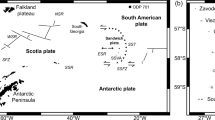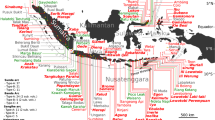Abstract
Located on Halmahera island, Dukono is among the least known volcanoes in Indonesia. A compilation of the rare available reports indicates that this remote and hardly accessible volcano has been regularly in eruption since 1933, and has undergone nearly continuous eruptive manifestation over the last decade. The first study of its gas emissions, presented in this work, highlights a huge magmatic volatile contribution into the atmosphere, with an estimated annual output of about 290 kt of SO2, 5000 kt of H2O, 88 kt of CO2, 5 kt of H2S and 7 kt of H2. Assuming these figures are representative of the long-term continuous eruptive activity, then Dukono is the current most prominent volcanic gas discharge point in Indonesia and ranks among the top-ten volcanic SO2 sources on earth. Combining our findings with other recent volcanic SO2 flux results, obtained during periodic campaigns at a number of volcanoes with DOAS and UV-Cameras, the SO2 emission budget for Indonesia is estimated at 540 kt year−1, representing 2–3% of the global volcanic SO2 contribution into the atmosphere. This figure should be considered as minimum as gas emissions from numerous other active volcanoes in Indonesia are yet to be evaluated. This voluminous degassing output from Dukono is sustained by a depleted Indian-MORB (I-MORB) mantle source. This latter is currently undergoing lateral pressure from the steepening of the subducted slab, the downward force from the Philippine Sea plate and the westward motion of a continental fragments along the Sorong fault, leading to high fluid fluxes to the surface. Over the course of Dukono eruptive activity, the magma reservoir has changed from a less differentiated source that fed the past voluminous lava flows to a more evolved melt that sustained the current ongoing explosive activity.






Similar content being viewed by others
References
Aiuppa A, Baker DR, Webster JD (2009) Halogens in volcanic systems. Chem Geol 263(1-4):1–18. https://doi10.1007/10.1016/j.chemgeo.2008.10.005
Aiuppa A, Bani P, Moussallam Y, Di Napoli R, Allard P, Gunawan H, Hendrasto M, Tamburello G (2015) First determination of magma-derived gas emissions from Bromo volcano, eastern Java (Indonesia). J Volcanol Geotherm Res 304:206–213. https://doi10.1007/10.1016/j.jvolgeores.2015.09.008
Aiuppa A, Fischer TP, Plank T, Robidoux P, Di Napoli R (2017) Along-arc, inter-arc and arc-to-arc variations in volcanic gas SO2/ST ratios reveal dual source of carbon in arc volcanism. Earth Sci Rev 168:24–47. https://doi10.1007/10.1016/j.earscirev.2017.03.005
Andres RJ, Kasgnoc AD (1998) A time-average inventory of subaerial volcanic sulfur emissions. J Geophys Res 103(D19):25251–25261. https://doi10.1007/10.1029/98JD02091
Bani P, Join J-L, Cronin SJ, Lardy M, Rouet I, Garaebiti E (2009a) Characteristics of the summit lakes of Ambae volcano and their potential for generating lahars. Nat Hazards Earth Syst Sci 9(4):1471–1478. https://doi10.1007/10.5194/nhess-9-1471-2009
Bani P, Oppenheimer C, Tsanev VI, Carn SA, Cronin SJ, Crimp R, Charley D, Lardy M, Robert TR (2009b) Surge in sulphur and halogen degassing from Ambrym volcano, Vanuatu. Bull Volcanol 71(10):1159–1168. https://doi10.1007/10.1007/s00445-009-0293-7
Bani P, Surono HM, Gunawan H, Primulyana S (2013) Sulfur dioxide emissions from Papandayan and Bromo, two Indonesian volcanoes. Nat Hazards Earth Syst Sci 13(10):2399–2407. https://doi.org/10.5194/nhess-13-2399-2013
Bani P, Normier A, Bacri C, Allard P, Gunawan H, Hendrasto M, Surono TV (2015) First evaluation of sulfur dioxide degassing from Anak Krakatau volcano, Indonesia. J Volcanol Geotherm Res 302:237–241. https://doi.org/10.1016/j.jvolgeores.2015.07.008
Bani P, Boudon G, Balcone-Boissard H, Delmelle P, Quiniou T, Lefèvre J, Garaebiti Bule E, Shinohara H, Lardy M (2016) The 2009-2010 eruption of Gaua volcano (Vanuatu archipelago): eruptive dynamics and unsuspected strong halogens source. J Volcanol Geotherm Res 322:63–75. https://doi.org/10.1016/j.jvolgeores.2015.06.023
Bani P, Alfianti H, Aiuppa A, Oppenheimer C, Sitinjak P, Tsanev V, Saing UB (2017) First study of heat and gas buget for Sirung volcano, Indonesia. Bull Volcanol 79(8):60. https://doi.org/10.1007/s00445-017-1142-8
Bogumil K, Orphal J, Homann T, Voigt S, Spietz P, Fleischmann OC, Vogel A, Harmann M, Kromminga H, Bovensmann H, Frerick J, Burrows JP (2003) Measurements of molecular absorption spectra with SCIAMACHY preflight model: instrument characterization and reference data for atmospheric remote sensing in the 230-2380 nm region. J Photochem Photobiol A 157(2-3):167–184. https://doi.org/10.1016/S1010-6030(03)00062-5
Burton MR, Sawyer GM, Granieri D (2013) Deep carbon emissions from volcanoes. Rev Mineral Geochem 75(1):323–354. https://doi.org/10.2138/rmg.2013.75.11
Cabral RA, Jackson MG, Koga KT, Rose-Koga EF, Hauri EH, Whitehouse MJ, Price AA, Day JMD, Shimizu N, Kelley KA (2014) Volatile cycling of H 2O, CO 2, F, and Cl in the HIMU mantle: a new window provided by melt inclusions from oceanic hot spot lavas at Mangaia, Cook Islands. Geochem Geophys Geosyst 15(11):4445–4467. https://doi.org/10.1002/2014GC005473
Cannatelli C, Doherty AL, Esposito R, Lima A, De Vivo B (2016) Understanding a volcano through a droplet: a melt inclusion approach. J Geochem Expl 171:4–19. https://doi.org/10.1016/j.gexplo.2015.10.003
Cardwell RK, Isacks BL, Karig DE (1980) The spatial distribution of earthquakes, focal mechanism solutions and subducted lithosphere in the Philippine and northeast Indonesian islands. Am Geophys Union Geophys Monogr 23:1–36
Carn SA, Clarisse L, Prata AJ (2016) Multi-decadal satellite measurements of global volcanic degassing. J Volcanol Geotherm Res 311:99–134. https://doi.org/10.1016/j.jvolgeores.2016.01.002
Carn SA, Fioletov VE, McLinden CA, Li C, Krotkov NA (2017) Adecade of global volcanic SO2 emissions measured from space. Sci Rep 7:44095. https://doi.org/10.1038/srep44095
Data Dasar Gunung api Indonesia (2011) Kementerian Energi dan Sumber daya Mineral, Badan Geologi. edisi kedua, 401–410
Davidson JP (1996) Deciphering mantle and crustal signatures in subduction zones. In: Bebout GE, Scholl DW, Kirby SH, Platt JP (eds) Subduction: top to bottom, vol 96. American Geophysical Union Monograph, pp 251–262
Dosso L, Bougault H, Beuzart P, Calcez JY, Joron JL (1988) The geochemical structure of the southeast Indian ridge. Earth Planet Sci Lett 88(1-2):47–59. https://doi.org/10.1016/0012-821X(88)90045-3
Elliott T, Plank T, Zindler A, White W, Bourdon B (1997) Element transport from slab to volcanic front at the Mariana arc. J Geophys Res 102(B7):14991–15019. https://doi.org/10.1029/97JB00788
Fischer TP (2008) Fluxes of volatiles (H2O, CO2, N2, Cl, F) from arc volcanoes. Geochem J 42(1):21–38. https://doi.org/10.2343/geochemj.42.21
Giggenbach WF (1996) Chemical composition of volcanic gases. In: Tilling R, Scarpa R (eds) IAVCEI-UNESCO: monitoring and mitigation of volcano hazards. Springer-Verlag, Berlin Heidelberg
Giggenbach WF, Tedesco D, Sulisiyo Y, Caprai A, Cioni R, Favara R, Fischer TP, Hirabayashi J, Korzhinsky M, Martini M, Menyailov I, Shinohara H (2001) Evaluation of results from forth and fifth IAVCEI field workshop on volcanic gases, Vulcano Island, Italy and Java, Indonesia. J Volcanol Geotherm Res 108:283–202
Global Volcanism Program (1978) Report on Dukono (Indonesia). In: Squires D (ed) Scientific event alert network bulletin, 3:8. Smithsonian Institution. http://dx.doi.org/10.5479/si.GVP.BGVN199306-268010
Global Volcanism Program (1993) Report on Dukono (Indonesia). In: Venzke E (ed) Bulletin of the global volcanism network, 18:6. Smithsonian Institution. http://dx.doi.org/10.5479/si.GVP.BGVN199306-268010
Global Volcanism Program (2006) Report on Dukono (Indonesia). In: Wunderman R (ed) Bulletin of the global volcanism network, 31:6. Smithsonian Institution. https://dx.doi.org/10.5479/si.GVP.BGVN200606268010
Global Volcanism Program (2007) Report on Dukono (Indonesia). In: Wunderman R (ed), Bulletin of the global volcanism network, 32:10. Smithsonian Institution. https://dx.doi.org/10.5479/si.GVP.BGVN200710268010
Global Volcanism Program (2013) Dukono (268010) in Volcanoes of the World, v. 4.6.3. In: Venzke E (ed) Smithsonian Institution. Downloaded 25 Nov 2017 (http://volcano.si.edu/volcano.cfm?vn=268010). https://doi.org/10.5479/si.GVP.VOTW4-2013
Gunawan H, Caudron C, Pallister J, Primulyana S, Christenson B, McCausland W, Van Hinsberg V, Lewicki J, Rouwet D, Kelly P, Kern C, Werner C, Johnson JB, Utami SB, Syahbana DK, Saing U, Suparjan PBH, Sealing C, Cruz MM, Maryanto S, Bani P, Laurin A, Schmid A, Bradley K, Agung Nandaka IGM, Hendrasto M (2016) New insights into Kawah Ijen’s volcanic system from the wet volcano workshop experiment. Geol Soc Lond, Spec Publ 437(1):35–56. https://doi.org/10.1144/SP437.7
Hall R, Wilson MEJ (2000) Neogene sutures in eastern Indonesia. J Asian Earth Sci 18:781–808
Halmer MM, Schmincke HF, Graf HF (2002) The annual volcanic gas input into the atmosphere, in particular into the stratosphere: a global data set for the past 100 years. J Volcanol Geoth Res 115:511–528
Johnson DM, Hooper PR, Conrey RM (1999) XRF Analysus of rocks and minerals for major and trace elements on a single low dilution Li-tetraborate fused bead. JCPDS-International Centre for Diffraction Data
Keppler H (1996) Constraints from partitioning experiments on the composition of subduction zone fluids. Nature 380(6571):237–240. https://doi.org/10.1038/380237a0
Le Roex AP, Dick HJB, Fisher RL (1989) Petrology and geochemestry of MORB from 25°E to 46°E along the southwest Indian ridge: evidence for constrasting styles of mantle enrichment. J Petrol 30(4):947–986. https://doi.org/10.1093/petrology/30.4.947
Le Voyer M, Rose-Koga EF, Laubier M, Schiano P (2008) Petrogenesis of arc lavas from the Rucu Pichincha and Pan de Azucar volcanoes (Ecuadorian arc): major, trace element, and boron isotope evidences from olivine-hosted melt inclusions. Geochem Geophys Geosyst 9(12). https://doi.org/10.1029/2008GC002173
Macpherson CG, Forde EJ, Hall R, Thirlwall MF (2003) Geochemical evolution of magmatism in an arc-arc collision: the Halmahera and Sangihe arcs, eastern Indonesia. In: Larter RD, Leat PT (eds) Intra-oceanic Subduction systems: tectonic and magmatic processes, vol 219. Geological Society, London, Special Publications, pp 207–220. https://doi.org/10.1144/GSL.SP.2003.219.01.10
McCormick BT, Edmonds M, Mather TA, Carn SA (2012) First synoptic analysis of volcanic degassing in Papua New Guinea. Geochem Geophys Geosyst 13(3):Q03008. https://doi.org/10.1029/2011GC003945
McCulloch MT, Gamble JA (1991) Geochemical and geodynamical constraints on subduction zone magmatims. Earth Planet Sci Lett 102(3-4):358–374. https://doi.org/10.1016/0012-821X(91)90029-H
Metrich N, Allard P, Aiuppa A, Bani P, Bertagnini A, Shinohara H, Parello F, Di Muro A, Garaebiti E, Belhadj O, Massare D (2011) Magma and volatile supply to post-collapse renewed volcanism and block resurgence in Siwi caldera (Tanna,Vanuatu arc). J Petrol 52(6):1077–1105. https://doi.org/10.1093/petrology/egr019
Monroe JS, Wicander R (2014) The changing earth, exploring geology and evolution, 7th edn. Cengage Learning, Stamford
Platt U, Stutz J (2008) Differential optical absorption spectroscopy, Principles and Applications. Springer, 597 pp
Rose-Koga EF, Koga K, Schiano P, Le Voyer M (2012) Mantle source heterogeneity for south Tyrrhenian magmas revealed by Pb isotopes and halogen contents of olivine-hosted melt inclusions. Chem Geol 334:266–279. https://doi.org/10.1016/j.chemgeo.2012.10.033
Saing UB, Bani P, Kristianto (2014) Ibu volcano, a center of spectacular dacite dome growth and long-term continuous eruptive discharges. J Volcanol Geotherm Res 282:36–42. https://doi.org/10.1016/j.jvolgeores.2014.06.011
Sawyer GM, Oppenheimer C (2006) Chapter 5: volcanic fluorine emissions: observations by Fourier transform infrared spectroscopy. Adv Fluorine Sci 1:165–185. https://doi.org/10.1016/S1872-0358(06)01005-0
Schiano P (2003) Primitive mantle magmas recorded as silicate melt inclusions in igneous minerals. Earth Sci Rev 63(1–2):121–144. https://doi.org/10.1016/S0012-8252(03)00034-5
Shinohara H (2008) Excess degassing from volcanoes and its role on eruptive and intrusive activity. Rev Geophys 46(4):RG4005. https://doi.org/10.1029/2007RG000244
Smekens JF, Clarke AB, Burton MR, Harijoko A, Wibowo HE (2015) SO2 emissions at Semeru volcano, Indonesia: characterization and quantification of persistent and periodic explosive activity. J Volcanol Geotherm Res 300:121–128. https://doi.org/10.1016/j.jvolgeores.2015.01.006
Sun S-S, McDonough WF (1989) Chemical and isotopic systematics of oceanic basalts. In: Saunders AD, Norry MJ (eds) Magmatism in the ocean basins, vol 42. Geological Society, London, Special Publications, pp 313–345. https://doi.org/10.1144/GSL.SP.1989.042.01.19
Surono et al (2012) The 2010 explosive eruption of Java’s Merapi volcano—a ‘100-year’ event. J Volcanol Geotherm Res 241–242(2012):121–135. https://doi.org/10.1016/j.jvolgeores.2012.06.018
Tamburello G (2015) Ratiocalc: software for processing data from multicomponent volcanic gas analyzers. Comput Geosci 82:63–67. https://doi.org/10.1016/j.cageo.2015.05.004
Van Padang N (1983) History of volcanology in the east indies. Scr Geol 71:1–76
Voigt S, Orphal J, Bogumil K, Burrows JP (2001) The temperature dependence (203–293 K) of the absorption cross-sections of O3 in the 230–850 nm region measured by Fourier-transform spectroscopy. J Photochem Photobiol A 143(1):1–9. https://doi.org/10.1016/S1010-6030(01)00480-4
Woodhead JD, Eggins S, Gamble JA (1993) High field strenght and transition element systematics in island arc and back-arc basin basalt: evidence for multi-phase melt extraction and a depleted mantle wedge. Earth Planet Sci Lett 114(4):491–504. https://doi.org/10.1016/0012-821X(93)90078-N
Acknowledgments
This work was achieved under the collaboration between Center of Volcanology and Geological Hazards (CVGHM) and Institut de Recherche pour le Développement (IRD) under the JEAI-Commission program. We gratefully acknowledge the technical assistance from Dukono Observatory. We thank B. McCormick and an anonymous reviewer for useful comments and suggestions. This is a Laboratory of Excellence ClerVolc contribution number 273.
Author information
Authors and Affiliations
Corresponding author
Additional information
Editorial responsibility: P. Allard; Deputy Executive Editor: J. Tadeucci
Rights and permissions
About this article
Cite this article
Bani, P., Tamburello, G., Rose-Koga, E.F. et al. Dukono, the predominant source of volcanic degassing in Indonesia, sustained by a depleted Indian-MORB. Bull Volcanol 80, 5 (2018). https://doi.org/10.1007/s00445-017-1178-9
Received:
Accepted:
Published:
DOI: https://doi.org/10.1007/s00445-017-1178-9




